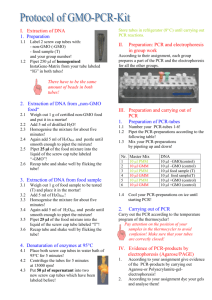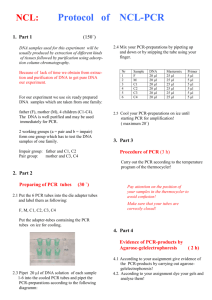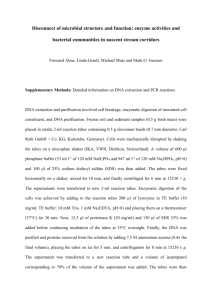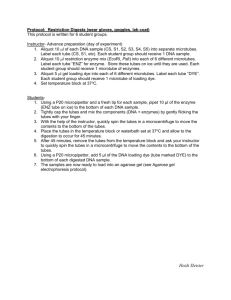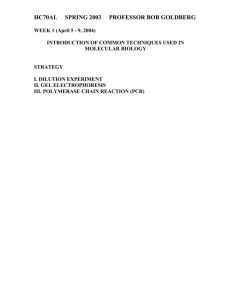GMO in Foods PCR Experiment Protocol
advertisement
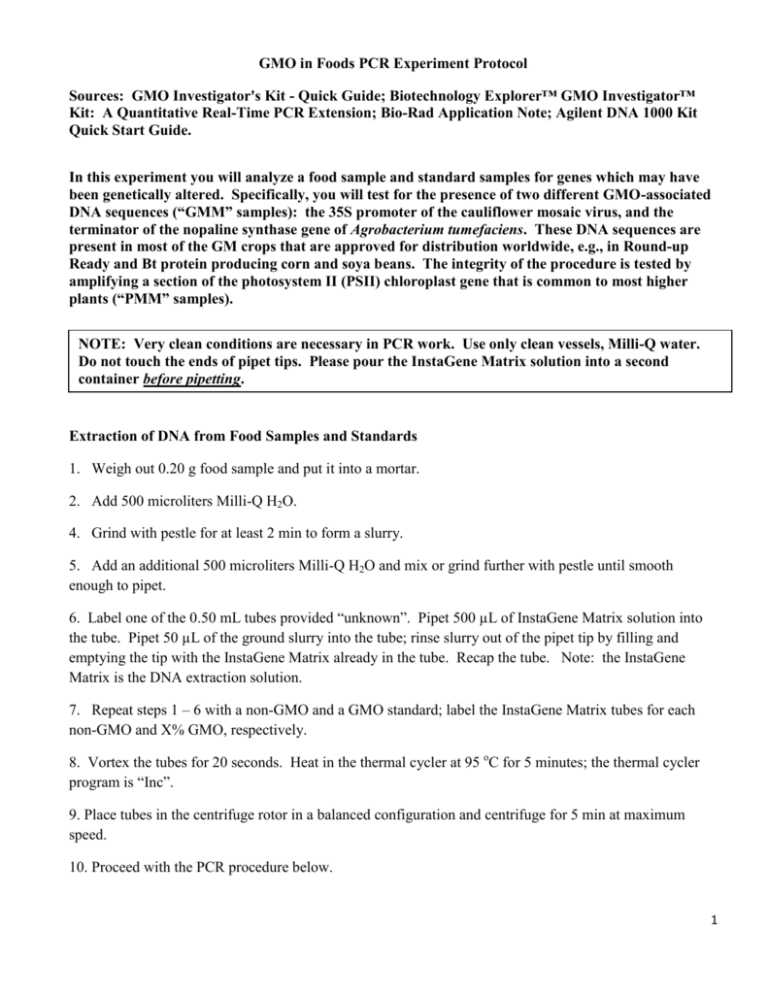
GMO in Foods PCR Experiment Protocol Sources: GMO Investigator's Kit - Quick Guide; Biotechnology Explorer™ GMO Investigator™ Kit: A Quantitative Real-Time PCR Extension; Bio-Rad Application Note; Agilent DNA 1000 Kit Quick Start Guide. In this experiment you will analyze a food sample and standard samples for genes which may have been genetically altered. Specifically, you will test for the presence of two different GMO-associated DNA sequences (“GMM” samples): the 35S promoter of the cauliflower mosaic virus, and the terminator of the nopaline synthase gene of Agrobacterium tumefaciens. These DNA sequences are present in most of the GM crops that are approved for distribution worldwide, e.g., in Round-up Ready and Bt protein producing corn and soya beans. The integrity of the procedure is tested by amplifying a section of the photosystem II (PSII) chloroplast gene that is common to most higher plants (“PMM” samples). NOTE: Very clean conditions are necessary in PCR work. Use only clean vessels, Milli-Q water. Do not touch the ends of pipet tips. Please pour the InstaGene Matrix solution into a second container before pipetting. Extraction of DNA from Food Samples and Standards 1. Weigh out 0.20 g food sample and put it into a mortar. 2. Add 500 microliters Milli-Q H2O. 4. Grind with pestle for at least 2 min to form a slurry. 5. Add an additional 500 microliters Milli-Q H2O and mix or grind further with pestle until smooth enough to pipet. 6. Label one of the 0.50 mL tubes provided “unknown”. Pipet 500 µL of InstaGene Matrix solution into the tube. Pipet 50 µL of the ground slurry into the tube; rinse slurry out of the pipet tip by filling and emptying the tip with the InstaGene Matrix already in the tube. Recap the tube. Note: the InstaGene Matrix is the DNA extraction solution. 7. Repeat steps 1 – 6 with a non-GMO and a GMO standard; label the InstaGene Matrix tubes for each non-GMO and X% GMO, respectively. 8. Vortex the tubes for 20 seconds. Heat in the thermal cycler at 95 oC for 5 minutes; the thermal cycler program is “Inc”. 9. Place tubes in the centrifuge rotor in a balanced configuration and centrifuge for 5 min at maximum speed. 10. Proceed with the PCR procedure below. 1 Figure 1. DNA extact tubes (one group samples). PCR Plate Setup It is essential to keep track of the placement of the individual sample tubes in the thermal cycler, as this is vital to the interpretation of the final results. To help identify and orient the PCR tubes sample trays, label the side of each PCR tube with an indelible marker. Figure 2. Final tray setup for PCR . The “Bio-Rad GMO DNA Positive Control” is a solution standard. The “No GMO Standard” and “GMO Standard” are extracts of standard reference materials with known concentration of GMO material. The “Sample” is the extract of your food sample. Preparing the Reagents for PCR 1. Locate the following reagents: • Mastermix for PCR • GMO-positive control DNA • Plant primers • GMO primers 2. Thaw all reagents on ice and mix by vortexing or gently tapping the tubes. 3. Centrifuge to force solutions to the bottom of the tubes (10 sec at full speed). 4. Keep on ice. 2 Diluting the Samples 5. Locate the Bio-Rad positive control GMO DNA (“Bio-Rad GMO DNA Standard”) in the GMO Investigator kit. 6. Label four 1.5 mL microtubes tubes for the samples indicated in Figure 1. Suggested labels are: “Con” - Bio-Rad GMO DNA Positive Control, “Non” - Non-GMO Standard, “L5” - GMO Standard (for Level 5), “Sample” - sample. 7. Add 10 μL of the unknown sample DNA extract to the tube labeled “Sample”, then add 1000 μL Milli-Q water*. Vortex tubes to ensure adequate mixing. * When diluting, pipet up and down repeatedly to make sure all DNA is rinsed from the tip and mixed thoroughly. Mix the tube thoroughly by vortexing for at least 10 sec or by flicking the tube at least 20 times. 8. Add 10 μL Non-GMO Standard DNA extract to the Non-GMO Standard tube, and add 1000 μL MilliQ water. Add 10 μL GMO Standard DNA extract to the GMO Standard tube, and add 1000 μL Milli-Q water. Mix and vortex tubes as above to ensure adequate mixing. 9. Add 1 μL of GMO-positive control DNA extract to the tube “Bio-Rad GMO DNA Standard”. Add 1000 μL Milli-Q water. Figure 3. Diluted sample tubes prior to preparing PCR tubes. Preparing the PCR Tubes 10. Label four 0.2 mL PCR tubes for amplification with plant template (PMM), and four with GMO DNA primers (GMM). For example, the four tubes for the group analyzing with plant primers will have the tube labels as follows: PBRCon PNOSTD PGMOSTD PSample Refer to Fig. 2 to decipher the name codes. Similarly, for the group with GMO primers: GBRCon GNOSTD GGMOSTD GSample 3 Preparing the Master Mix 11. Label two 0.5 mL tubes as follows: • “PMM” for “plant master mix” • “GMM” for “GMO master mix” 12. Add 100 L of the Mastermix to both the PMM and the GMM tubes. 13. Add 1.0 μL of plant primer to the tube labeled “PMM”. Pipet up and down repeatedly to make sure all DNA is rinsed from the tip; mix thoroughly and vortex. 14. Add 1.0 μL of GMO primer to the tube labeled “GMM”. Pipet up and down repeatedly to make sure all DNA is rinsed from the tip; mix thoroughly and vortex. Adding Master Mix to PCR Tubes 15. Aliquot 12.5 μL of plant master mix (PMM) to each of the four PCR tubes labeled “P___” in Step 10. 16. Aliquot 12.5 μL of GMO master mix (GMM) to each of the four PCR tubes labeled “G___” in Step 10. 17. Figure 4 shows the PCR tubes for each student group, ready for addition of the samples. Figure 4. Tubes ready for PCR thermal cycler. Adding the DNA Samples to the Tubes 18. Add 12.5 μL of Bio-Rad GMO DNA Positive Control to the PCR tube labeled PBRCon, and the same to the tube labeled GBRCon. Add 12.5 μL of the diluted Non-GMO Standard (“Non” tube, Step 8) to both the GNOSTD and PNOSTD PCR tubes, 12.5 μL of the diluted GMO Standard (“L5” tube) to both the GGMOSTD and PGMOSTD PCR tubes, and finally 12.5 μL of the diluted sample to both the GSample and PSample tubes. Be sure to use a fresh pipet tip with each tube. Mix each reaction gently by slowly pipeting up and down several times, without withdrawing the pipet tip. 19. Cap the tubes securely. 4 Running PCR Reactions 20. Place the PCR tubes in the thermal cycler. Be careful to organize the tubes so you will know the identity of each when you remove it. 21. Start the “PCR” program. The DNA amplification will require approximately 200 min. 22. Remove the tubes, again being careful to retain the organization when transferring to the tube tray. Refrigerate prior to analysis. Thermal Cycler Program (stored as program “GMO”): The reaction volume will be 25 μL. The lid temperature is 95°C. Cycle 1: 95°C for 4 min initial denaturation of DNA Cycle 2: 94°C for 1 min denaturation 59°C for 1 min annealing 72°C for 2 min extension Repeat Cycle 2 for 40 cycles Using the Agilent Bioanalyzer 2100 Familiarize yourself with the instructions for preparing the DNA chip given below. The preparation should be done both precisely and quickly. 23. Follow the steps below to set up the lab-on-a-chip and place into the instrument. Note that the chip must be analyzed within 5 min of vortexing. 24. Software setup: Open the Agilent expert program on the attached PC. Select DNA 1000 as the analysis. 5 25. Type in the sample names which correspond to sample placement in the chip (this step can be performed while the device is running the analysis.) 26. Click the start button in the software. It takes approximately 30 minutes for the Bioanalyzer to run 12 samples. [Attach Agilent DNA 1000 Kit Quick Start Guide] 6
